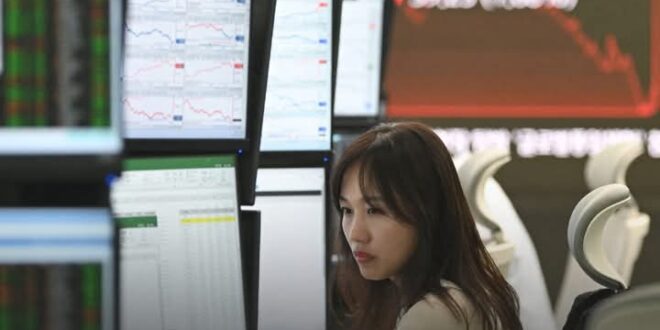The global financial markets have been rattled once again as Asian stocks tumbled and US futures slid following the implementation of former President Donald Trump’s renewed tariff policies on China.
The move, which marks a significant escalation in trade tensions between the world’s two largest economies, has sent shockwaves through international markets, raising concerns over economic stability and global supply chains.
The Tariff Policy and Its Implications
Trump’s latest tariff strategy, which has now gone into effect, imposes new duties on a range of Chinese goods, including critical technology components, industrial materials, and consumer products.
This aggressive trade stance is reminiscent of his previous administration’s policies, which led to economic uncertainty and volatile stock market movements.
The aim, according to Trump, is to curb China’s economic influence and reduce the US trade deficit, but history has shown that such tariffs often lead to retaliatory measures from Beijing, further exacerbating tensions
Market Reactions in Asia
Asian stock markets reacted negatively to the news, with key indices experiencing sharp declines.
The Nikkei 225 in Japan fell by over 2%, while Hong Kong’s Hang Seng Index and China’s Shanghai Composite also reported significant losses.
Investors are wary of a potential slowdown in trade and the impact on multinational companies reliant on Chinese manufacturing and supply chains
.Moreover, the weakening of the Chinese yuan against the US dollar indicates mounting pressure on China’s economy, as businesses brace for increased costs and supply chain disruptions.
Analysts warn that these tariffs could further weaken China’s economic growth, already under strain due to sluggish domestic demand and regulatory challenges.
Impact on US Futures and Global Trade
The negative sentiment has also extended to Wall Street, with US stock futures slipping ahead of the market opening. Tech and manufacturing sectors are expected to be hit the hardest, given their dependence on Chinese imports for raw materials and components.
Companies like Apple, Tesla, and semiconductor manufacturers may face higher production costs, which could be passed on to consumers.Global trade networks are also at risk, as businesses seek alternative suppliers to bypass the tariff burdens.
However, shifting supply chains is neither quick nor easy, meaning disruptions are likely in the short term, potentially affecting industries from electronics to automotive manufacturing.
China’s Possible Retaliation
China has historically responded to US tariffs with countermeasures, and experts predict Beijing will introduce its own set of restrictions. This could include increased tariffs on American agricultural products, restrictions on US companies operating in China, or even a shift in global trade alliances, strengthening ties with Europe and emerging economies.
With China being a dominant player in global trade, any retaliatory measures could deepen economic uncertainty and contribute to further market volatility.
Investors and analysts are closely watching how Beijing will respond in the coming days.
What’s Next?
As tensions escalate, the biggest concern for global markets is the long-term impact of this renewed trade war.
If both nations continue down this path, the global economy could see slower growth, disrupted trade networks, and prolonged stock market instability.
While Trump’s policy aims to boost domestic manufacturing and reduce reliance on China, businesses and consumers alike could face higher costs and decreased market confidence.
For now, investors will be keeping a close eye on diplomatic developments, economic data, and corporate earnings reports to gauge the full impact of these tariffs.
The reintroduction of Trump’s China tariffs has reignited uncertainty in global markets, leading to a significant drop in Asian stocks and US futures.
As trade tensions escalate, businesses and investors must prepare for potential retaliatory measures from China and ongoing economic disruptions
. With the global economy already facing challenges from inflation and geopolitical conflicts, this latest trade war development could further complicate the road to stability.
The coming weeks will be crucial in determining how deep this economic strain will go and whether diplomatic efforts can ease tensions before more damage is done to global trade and financial markets.
 Top Trends Blogs
Top Trends Blogs




